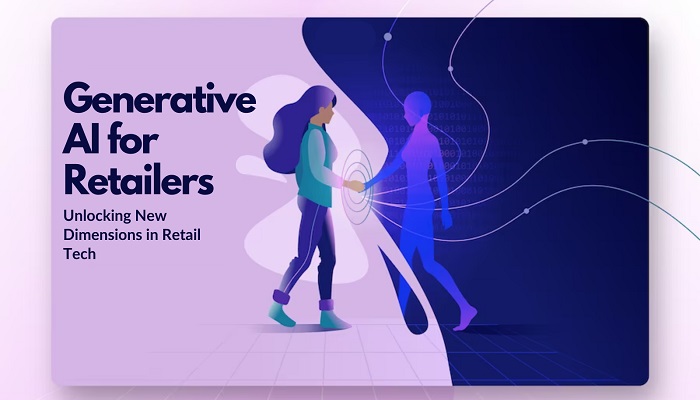Generative AI like ChatGPT and Copy.AI brings efficiency and creativity, speeding up how professionals perform. As reported in the Convenience Leaders Vision group (CVLG) June 2023 Vision Report, “A new level of performance is being unlocked because of AI,” says Tom Svrcek, Analytics Partner at McKinsey & Company. This blog will unravel the potential of Generative AI for retailers and its impact on various aspects of the industry.

How Generative AI Transforms Customer Experience?
According to CLVG member Hal Adams, the way things change with AI today is the predictive element of understanding what’s happening fast enough to be able to change the result. “There are things you can do and react to much more quickly that you probably couldn’t do before AI,” he said, noting that when AIis in place, it elevates a traditional forecasting model.
1. Personalized Recommendations and Targeted Marketing:
With the right machine learning algorithms, retailers can analyze customer data and make accurate predictions about future buying behavior. This personalized approach can increase customer satisfaction and enhance targeted marketing efforts, leading to higher conversion rates and customer loyalty.
2. Improving Predictive Analytics and Demand Forecasting
“Generative AI can eradicate inaccuracies,” said Drayton McLane Jr, Chairman, McLane Group, in CLVG Vision Group Report June 2023, emphasizing its significance for store managers in generating precise orders and maintaining optimal stock levels. McLane also pointed out that “The weakness in ordering for convenience stores is that most orders are completed by the convenience store manager.” Those orders are based on available shelf stock. “That’s proven to be very inaccurate,” he added.
Stores are aware of their inventory and combining that information with AI can help in improving accuracy. Based on that data, AI can create the order. He strongly believes that utilizing AI in this manner has proven to be remarkably accurate and effective for various companies. Furthermore, McLane highlights the success of AI-driven inventory management solutions, stating, “It would be very hard for humans to put all those combinations in their head and process those things.”
“You want data not for one year, but maybe data for six or seven years. Convenience store demand changes instantly depending on the weather that particular day”, according to Mclane.
He added, “You need to go back six or seven years on the weather trends. And so if you’re making up an order, ultimately you’re scanning the number of items in and out, so you know how much inventory you have. Leveraging AI technology, retailers utilize this inventory data to generate orders for the following week. By considering seasonal factors, holidays, promotional items, and weather conditions, the computer can analyze this information and generate a comprehensive order”.
3. Streamlining Pricing and Dynamic Pricing Strategies:
Pricing strategies are paramount in the retail industry, and Generative AI streamlines this process by analyzing market dynamics, competitor pricing, and customer behavior. By properly implementing the correct Generative AI tools, your business can adjust prices based on demand, inventory, and customer preferences, optimizing revenue while staying agile in a competitive market.
4.Virtual Shopping Assistants and Chatbots:
Generative AI paves the way for developing virtual shopping assistants and chatbots that provide personalized and interactive customer support. These virtual assistants engage with customers, provide product recommendations per their preferences, answer queries, and assist in purchasing. By leveraging natural language processing and machine learning, virtual shopping assistants offer an intuitive shopping experience, reducing wait times and providing convenience.
5.Visual Search:
Customers don’t always search for the right things, but Generative AI opens up exciting possibilities for visual search in the retail industry. With Generative AI, customers can upload the product they like, and AI can suggest similar products from the inventory. This enhances the shopping experience by providing a more visual way of discovering products.
6. Augmented Reality:
In retail, Generative AI combined with AR enables customers to try on virtual clothes, accessories, or makeup, providing a realistic preview of how products will look on them. Additionally, AR-powered virtual try-ons for furniture and home decor help customers visualize how items fit into their living spaces before making a purchase. By leveraging Generative AI to improve the accuracy and realism of AR experiences, retailers can create more compelling and personalized interactions, leading to higher conversion rates and stronger brand loyalty.
7. Fraud Detection and Prevention:
Fraudulent activities have always been a problem in the retail industry. Now with Generative AI, you can analyze vast amounts of data, including transaction history, customer behavior patterns, and other external factors. This analysis can detect anomalies and patterns associated with fraudulent activities. Retailers can identify and mitigate risks, better protecting themselves and their customers from fraudulent transactions than ever capable before.
Conclusion:
Generative AI holds immense promise in transforming the retail industry. With many new apps being created so rapidly, it is important to be proactive in order to stay ahead and truly maximize this new technology for your business. By hiring the right team or partnering with the right companies, Generative AI can be a tool that thrusts you into the next era of your business.
